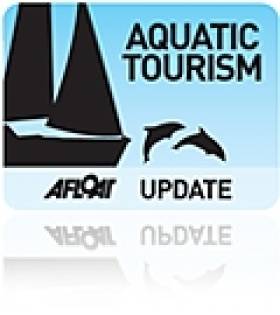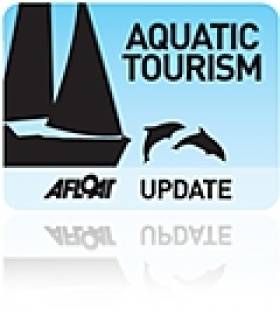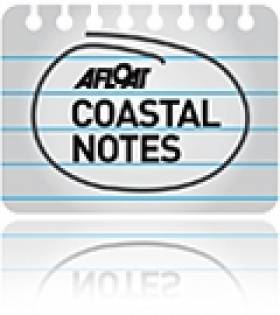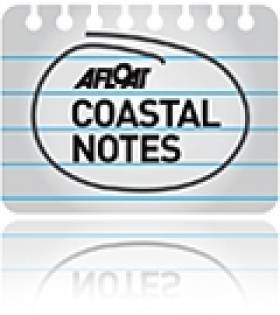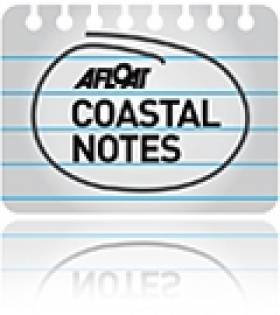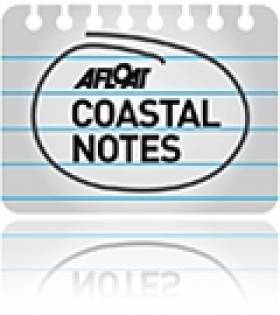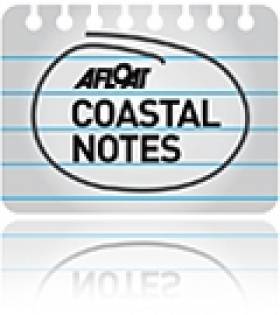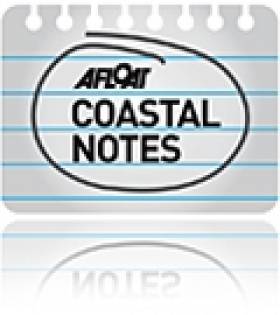Displaying items by tag: Coastal Notes
Wild Atlantic Way Is Magazine's Choice For 'Best Tourist Attraction'
#WildAtlanticWay - The Wild Atlantic Way was recognised as ‘Best Tourist Attraction’ at the third InBusiness Editors' Choice Awards at a ceremony in Dublin's Hibernian Club.
Fáilte Ireland says it invested €10 million during 2014 in what's Ireland’s first long-distance touring route, stretching from the Inishowen Peninsula in Donegal to Kinsale in Co Cork.
And the news comes in the same week as the Loop Head Peninsula, a key attraction on the route, was named as one of the world's top 100 sustainable travel destinations.
"The enthusiasm out there for this project is impressive and not only amongst tourism businesses but also in the wider community," said Fiona Monaghan, head of the Wild Atlantic Way project for Fáilte Ireland. "The key to success for this initiative is its authenticity – not just the places but also the people of the Wild Atlantic Way.
“With its capacity to drive extra visitor footfall, mobilise communities and showcase the best of the West Coast of Ireland, the Wild Atlantic Way is set to be one of the most significant developments in modern Irish tourism and to be a significant engine of regeneration for rural Ireland," she added.
"I have no doubt that there is at least a decade of growth in the Wild Atlantic Way and is already luring visitors to Ireland as they seek to explore the longest defined coastal route in the world.”
Irish companies and individuals were recognised at the InBusiness Editor’s Choice Awards, which honour outstanding achievement in the Irish business community. Winners were selected based on the broad criteria of growth, profile of business, range of services and customer care.
Loop Head Named As Top Sustainable Tourism Destination
#Tourism - Loop Head Peninsula has been named as one of the world's top 100 sustainable travel destinations, as The Irish Times reports.
The breathtaking Clare coastal spot is featured with the likes of the UK's Lake District and New Forest, Easter Island in the Pacific and the Wild Coast in South Africa's Eastern Cape in the first Sustainable Destinations Global Top 100 travel guide.
The Irish Times has more on the story HERE.
Former Aran Island Ferries Meet in Dublin's Grand Canal Dock Basin
#FormerAranFerries - In recent weeks St. Bridget another former Aran Islands ferry entered Dublin's Grand Canal Dock Basin to join Naomh Éanna, the 1956 built ship that served CIE until withdrawn from service in 1988, writes Jehan Ashmore.
The veteran 300 passenger and freight ferry is berthed in a disused dry-dock and was the topic of a TG4 documentary recently broadcast. Moored nearby is the 1977 built St. Bridget with a 120 passenger capacity that is in winter lay-up following a second season operating coastal excursions for Dublin Bay Cruises.
It is ironic the pair should be sharing company together, given plans to restore and refit the riveted 137ft hulled Naomh Éanna as a tourist attraction and return her westbound to her old homeport of Galway. Whereas St. Bridget, formerly named Galway Bay, was repositioned last year for east coast duties for newcomer Dublin Bay Cruises.
St. Bridget's season this year involved an expanded network of excursion routes linking Dublin city-centre, Howth and Dun Laoghaire harbours in addition to running an evening cruise to Killiney Bay.
According to the operator, the most popular excursion service was Dublin City via the Dun Laoghaire to Howth service. As well as these sight-seeing services St. Bridget served clients for private charters.
As the Galway Bay, not to be confused with other ferries of the same name, (notably the restored Calshot in Southampton), her career on the western seaboard included Rossaveal to Kilronan. She then had a spell on the Cleggan-Inishbofin service.
In recent times it is understood she returned to Aran service when running from Co. Clare under her current owner's sister company Doolin2Aran Ferries.
The 26m steel-hulled St Bridget is one of five passenger ships owned and operated by the Garrihy family which run both the companies. She is scheduled to resume regular sailings in April 2015.
Dead Jellyfish On Galway Beach Still Pack A Sting, Experts Warn
#Jellyfish - Summer may be long gone, but jellyfish attracted by the warmer waters of recent months are still posing a hazard on Galway's beaches, as the Connacht Tribune reports.
Recent weeks have seen Salthill strewn with the remains of hundreds of dead mauve stingers, which can still pack a punch even after death.
Meanwhile, though marine science boffins are not surprised by the sheer numbers of the seaborne creatures in Galway Bay as this period is their mating season, they are concerned that so many are being washed ashore.
The jellyfish warning comes not long after Fáilte Ireland's falling afoul of locals for advising against bathing at Salthill's popular strand.
While recommending the city suburb's famous promenade for walking and sightseeing, the tourism board's Discover Ireland website reportedly stated that "swimming is not recommended" at the adjacent beachs.
No reasons were given for this advice, which has raised the ire of locals including Labour Party city councillor Niall McNelis, who said: “I cannot understand why Fáilte Ireland would warn people not to swim in Salthill. It has a Blue Flag."
Phillips 66 Pulls Out of Sale of Whitegate Oil Refinery
#WhitegateOilRefinery – The Irish Independent writes that the US oil company, Phillips 66 has pulled the sale of Ireland's only oil refinery at Whitegate in Cork as attempts to find a buyer failed.
Last June, Phillips 66 hired Deutsche Bank to help sell the refinery. However, despite smoking out several potential suitors, the company and its advisers were unable to seal a deal.
Phillips 66 will continue to operate the refinery in Cork, although it may seek to offload a nearby storage facility in Bantry Bay. Around 200 staff are employed by Phillips 66 across its Irish operations. For more on the story click HERE
As previously reported on Afloat.ie last year the Government-commissioned a report that said the state did not need its own oil refinery as it can import enough of the fuel to meet all its needs.
For a copy of the report published by the Department of Energy, click HERE.
#EastLink@30 – Naval Service OPV L.E. Aisling (P23) took the honour of passing through Dublin's East-Link Toll Bridge as the Liffey road crossing celebrated opening to traffic 30 years ago today, writes Jehan Ashmore.
The final of the 'Emer' OPV class built sisters made the transit of the bridge built to a bascule design in which the 'lifting' span of 45 metres wide was raised. The opening span weighing 500 tons is tilted to 80 degrees and taking less than a minute to complete. This allowed the L.E Aisling to continue upriver to berth along Sir John Rogersons Quay.
When the bridge was opened on 21st October 1984, this created a new eastern by-pass of the capital however this was to be an end of era with the withdrawal of the Liffey ferry, albeit a foot-passenger only service.
The ferry was used as short cut mostly for 'dockers' as otherwise the next fixed link bridging the Liffey three decades ago was the Matt Talbot Memorial Bridge. This structure was close to where the last Guinness stout-ships berthed, The Lady Patricia and Miranda Guinness along Sir John Rogersons Quay.
The stout-tankers were the last ships to regularly transit the East-Link Bridge until 1993. They exported the 'black stuff' to Runcorn on the Manchester Ship Canal.
The East-Link Bridge has a strong commuter profile with approximately 17,500 vehicles daily using the bridge connecting the north and south quays. The bridge spanning 150 metres was the vision of Tom Roche (senior) founder of the National Toll Roads, the original operators of the tolled bridge.
Not only is the bridge used by car motorists but notably is a national strategic infrastructure asset for freight trucks to access the port. As the years passed with the opening of the Dublin Port Tunnel, this formed another key part of the overall port related road network and to further alleviate congestion away from the city-centre quays.
Another milestone in the infrastructure of bridging the Liffey was the Samuel Beckett Bridge which ironically itself made a transit through the East-Link Bridge. The structure was loaded on board a barge in The Netherlands and was towed to Dublin Port in 2009 for installation. The Samuel Beckett Bridge is of a swing-bridge design in which the whole bridge pivots on a single pier.
It was in May this year when another of the Naval Service's OPV's the newbuild L.E. Samuel Beckett (P61) moored close to the bridge also bearing the name of the playright as the vessel was christened along the south quays.
For a speeded up footage taken on board from the mast of the newbuild as she headed into Dublin Port and through the East-Link Bridge prior to her naming ceremony, click HERE.
#Oil&Gas - The Government is redoubling efforts to survey Ireland's coastal waters for new and exploitable oil and gas resources – and determine their impact on the ecosystem and protected marine wildlife.
As TheJournal.ie reports, the pronouncement by Minster of State for Natural Resources Joe McHugh at this year's Atlantic Ireland Conference means that the "very significant" momentum of the State's licensing of offshore seismic surveys will continue.
At the same time, the minister says his department is teaming with the National Parks and Wildlife Service to collect new data on marine wildlife in Ireland's coastal waters with a view to mitigating the impact of petroleum exploration on protected species such as whales and dolphins.
Only two months ago the Irish Whale and Dolphin Group proposed a restriction on seismic surveys on the edge of the continental shelf to avoid disturbance to migrating blue whales and fin whales.
TheJournal.ie has more on the story HERE.
Cargo Dust from Ringaskiddy Clogged Pfizer Filters
#CargoDustPfizer – The Examiner writes that in a serious incident dating to last year, the Port of Cork has admitted it was involved when dust from cargo being unloaded in Ringaskiddy clogged the air filters of a major pharmaceutical plant.
The revelation came at a Bord Pleanála oral hearing during cross-examination of port officials by objectors to its plans for a €100m-plus upgrade of its cargo-handling facilities at Ringaskiddy.
Concern expressed by local residents over dust emissions prompted Cork Harbour Environmental Protection Association (CHEPA) member Bob McLaughlin to reveal three pictures he took on February 21 last year. They showed significant amounts of dust being spread into the atmosphere while a ship was being unloaded.
The dust blew into the air filtration systems on the roof of the Pfizer plant. The Examiner paper has more on this story click HERE.
‘Rotten Eggs’ Smell in Cork City Blamed on Dredging Works
#CitySmell - Strong smells affecting Cork city for the past four days are being blamed due to dredging works near the city quays.
The Environmental Protection Agency (EPA), which monitors air quality in the city, said the disturbance of marine sediments could give rise to a release of hydrogen sulphide, which would explain the sulphur or rotten eggs odour.
Shoppers, business owners and visitors to Cork have all reported a foul smell at various locations since Saturday. For more on this the Evening Echo has a report.
Join The World’s Largest Coastal Cleanup This Weekend
#BigBeachClean - Clean Coasts’ Big Beach Clean is happening this weekend 20-21 September. And once again Clean Coasts is teaming up with the International Ocean Conservancy for the International Coastal Cleanup event.
Last year 645,015 volunteers in nine countries removed 5,580 tonnes of marine litter from the world's oceans. This year’s Big Beach Clean aims to be the biggest yet, with 100 cleanups taking place (find a cleanup near you or register a beach to clean up at www.bigbeachclean.ie).
During the Big Beach Clean, Clean Coasts volunteers are asked to carry out marine litter surveys to quantify the amount and types of marine litter on Irish beaches. These surveys are aimed at heightening awareness about the issue of marine litter and serve as an indicator of the magnitude of the problem.
Speaking about the Big Beach Clean, Clean Coasts national manager Annabel FitzGerald said: “Marine litter is a global concern, affecting all the oceans of the world. Every year, millions of tonnes of litter end up in our seas and oceans, posing environmental, economic, health and aesthetic challenges.
"Ireland boasts spectacular sandy beaches and rocky shores and we all have a responsibility in caring for it. Every single piece of litter removed during the Big Beach Clean is one less piece of litter that will pollute our beautiful beaches or harm wildlife.”
Clean Coasts ambassador Easkey Britton also spoke about her support of the Big Beach Clean. “The ocean is important - our personal health and wellbeing is so interconnected with the health of our coasts and ocean but it's in trouble," she said.
"Marine litter is a big issue but each one of us has the power to do something about it and make a real impact for our health and the ocean's. Take action now and register for the Big Beach Clean!”


























